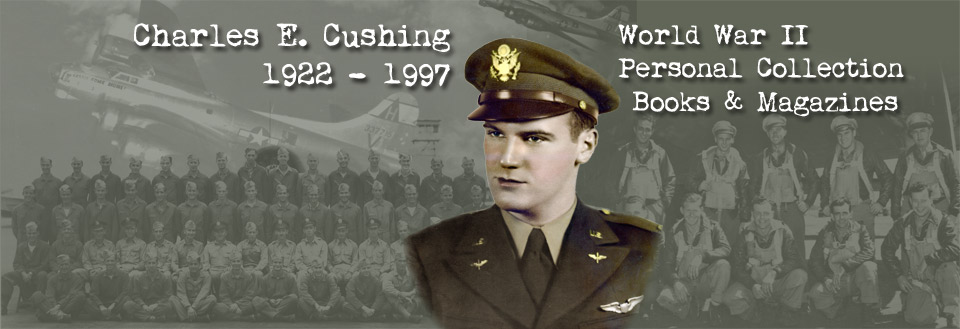|
Click each cover to view or download the
contents in a PDF file from TampPix's DropBox.
|
|
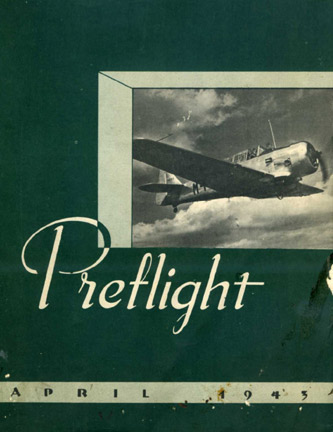
File size 4.7 Mb |
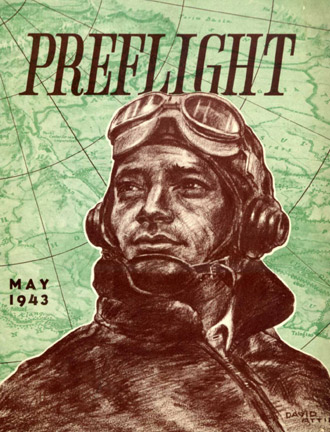
File size 5.6 Mb |
|
U.S. Army Air Forces Corps of Aviation
Cadets , Preflight School for Pilots, Maxwell Field, Alabama.
April 1943. The booklet is an
account, in words and pictures, of the story of the class of 43J at
Maxwell Field, of which Charles was a member. They come to
Maxwell raw, untrained, the majority from civilian life with only a
month's basic training at a classification center. But
like the thousands who came before, they learn quickly.
They receive the educational background
for use in advanced training stages; they toughen their bodies, take
inches off their belts. Their minds become alert, muscles
coordinated. Honor, cleanliness, efficiency and pride become
an inherent part of every cadet's life before he leaves Maxwell.
To those cadets who go on to win their wings, their mission at
Pre-Flight completed, Maxwell is where they prepared for combat. |
U.S. Army Air Forces Corps of Aviation
Cadets , Preflight School for Pilots, Maxwell Field, Alabama.
May 1943. This issue of Preflight
records the tangible things at Maxwell, things like the Burma Road,
range and gunnery school, Open Post, Squadron life, code and math.
It also tells the story of a class--the Class of 43-K. To
most of us, as we prepare to leave, this is the beginning of a new
experience. Primary, Basic and Advanced [training] lie ahead
and with them the goal for which all of us are striving--to fight
this war in the air.
Here at Maxwell, we prepare for combat.
Our training is basic. There are no flight lines for Preflight
cadets. Instead, there is school, drill and calisthenics.
But in preparing for missions that will take us over Europe, the
Pacific area, China and Japan, we are also preparing to safeguard
the freedoms we win. When the last flight has been completed
it will be our task to make certain those freedoms and our way of
life shall never again be threatened. |
|
|
|
|
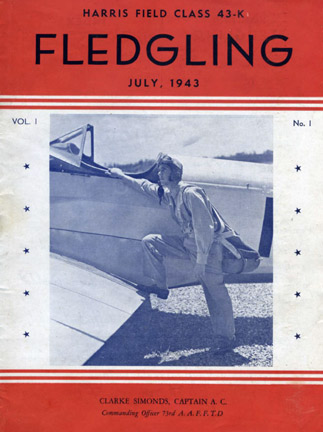
File Size 2.5 Mb |
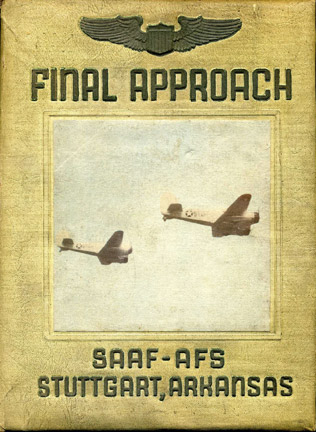
File Size 13.6 Mb |
|
U.S. Army Air Forces Corps of Aviation
Cadets, Primary Flight School for Pilots, Harris Field, Cape Girardeau, Missouri - July, 1943.
Harris Field was created from five Missouri
farms into an Army Air Force primary training school in four months.
Work was begun on Aug. 1, 1942 to transform the farmland into a
flight training field for Aviation Cadets.
Harris Field was the "Pearly Gates" to
Aviation Cadets; it was the place where they would actually learn to
fly a plane. Here they would find out that the flying game had
its unromantic side as well as its glamorous side.
With a gleaming pair of silver wings as
their goal, they studied meteorology, aircraft recognition, aircraft
engines, air navigation and flight theory.
According to Charles' individual flight
records, he logged 26 hrs of dual flight and 39 hrs in solo flight,
for a total of 65 hours, 4 min. of flight time as an Aviation Cadet
in July, 1943.
See Charles'
Primary
Flight Training certificate from the Cape Institute of
Aeronautics, Harris Field, Mo. |
"Final Approach" - Stuttgart Army Air Field,
Stuttgart, Arkansas, Oct./Nov. 1943
Absent from the Cushing collection is a
publication for Charles' Student Pilot Basic
Training at Malden Army Air Field in Missouri, Aug./Sep.
1943, where according to his individual flight record, he logged 35
hrs, 40 min of daytime dual flight and 42 hrs. 55 min. of daytime
solo flight, including formation, acrobatics, and solo cross-country
time on
VulTee BT13A aircraft and 100 hours on Link Trainers.
This Stuttgart graduation book contains
photos and stories about the events that transpired at SAAF in Oct.
& Nov. of 1943 for the class of 43-K. It also contains photos
of all the personnel and cadets. This was the first class of
Aviation Cadets to graduate from SAAF under the new command of Col.
Casper P. West.
It was here at Stuttgart that Cadets would
finally become pilots and earn their silver wings at graduation.
But all is not flying at Stuttgart. Here, Cadets learn
Navigation, Aero-Equipment, Bombing Aircraft, Naval Recognition,
Code and Armament.
Here at SAAF, Charles flew Beech AT-10
aircraft and logged 76 hrs.
of advanced flight time, as well as 24 hours of instrument flight,
22 hrs. of night flight, and 13 hrs of instrument trainer flight.
|
|
Stuttgart continued: The United States
Army Air Forces (USAAF) opened the Stuttgart Army Airfield in
October 1942. The airfield was located in Prairie County on
approximately 2,682 acres about seven miles north of Stuttgart
(Arkansas County). The facility consisted of four 5,000-foot runways
and facilities for 6,000 personnel.
From May 1943 to December 1944, the airfield
was used to train pilots in the operation of twin-engine planes.
There were also Women Air Force Service Pilots (WASPs) stationed at
Stuttgart. The WASPs flew the twin-engine Beech AT-10 “Wichita,” the
single-engine AT-6 “Texan,” the twin-engine Cessna UC-78 “Bobcat,”
and the single-engine Noorduyn UC-64 “Norseman” as engineering/test
pilots, ferrying pilots, and administrative/courier pilots. The
airfield was deactivated in December 1944. The Department of War
declared the airfield excess in August 1946, and the entire site was
eventually deeded to the City of Stuttgart. (Information
from Encyclopedia of Arkansas History & Culture.)
|
|
|
|
|
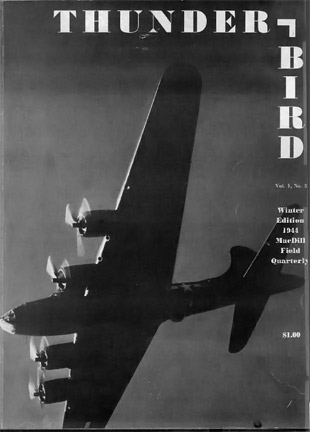
File Size 16.8 Mb |
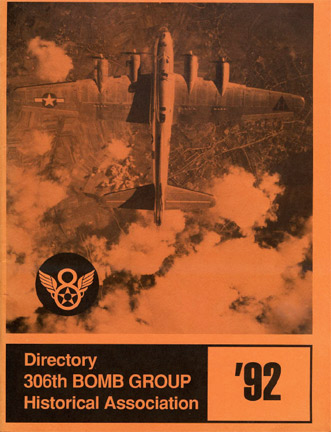
File size
.8 Mb |
|
"Thunderbird" - MacDill Field, Tampa, FL
Quarterly, Winter Edition 1944.
2nd Lt. Cushing arrived at MacDill in early January,
1944 from Avon Park, FL and had
the rank of 2nd Lieutenant in the 3rd Air Force, Bomb Group 488 (H).
He was stationed at MacDill through April 5, 1944, during which time
he logged over 130 combined day and night hours of flight time on
B-17F and B-17G bombers.
On
July 14, 1939, after months of considering several locations in the
Southeast U.S. for a new Army Air Field, the momentous announcement
was made that Gen. Thomas Handy, who had been conferring with a
Tampa committee for weeks, had decided that the base should be
located at the lower end of Interbay Peninsula, known as Catfish
Point, and it was to be named Southeast Air Base.
Almost simultaneously with the onset of work on
the airfield, Secretary of War Harry H. Woodring announced a change
of name for the future base on November 30, 1939. It was to be named
after Colonel Leslie MacDill, who had died test-flying a BC-1
aircraft, along with the mechanic, in a
crash on
the outskirts of Washington, D.C., on November 9, 1938.
Operations began on the base in late 1939 as
construction continued. The base was formally dedicated on
April 16, 1941.
See a
history of MacDill AFB with photos here at TampaPix.
|
306th Bomb Group Historical Association
Directory, 1992 Front and back
cover and the information page only. The rest of the directory
consists of contact information for the members of this group
arranged in different sections by last name or geographic location.
Charles wasn't listed in this directory.
Based at RAF Thurleigh, Bedfordshire, in
south-central England, as part of the Eighth Air Force, the 306th
was the longest continuously-serving bomb group of the Eighth Air
Force during World War II, and led the first mission against a
target in Germany.
Between October 1942 and April 1945, the
Group bombed a variety of enemy targets in Europe, including
railroad facilities and submarine pens in France and ball-bearing
works, oil plants, marshaling yards, chemical plants, aircraft
factories, and foundries in Germany. The group took part in the
first penetration into Germany by heavy bombers of the Eighth Air
Force on 27 January 1943 by attacking the U-boat yards at
Wilhelmshaven.
The 306th Bomb Group was the first Eighth
Air Force heavy bombardment group to complete 300 missions over
Occupied Europe and Nazi Germany and also was the first United
States Army Air Forces heavy bombardment group to attack a strategic
target located in Nazi Germany when the group, led by Colonel Frank
A. Armstrong, attacked Wilhelmshaven on 27 January 1943.
Colonel Armstrong's experiences with the
97th and 306th groups became the basis of Sy Bartlett and Beirne
Lay, Jr.'s novel and film Twelve O'Clock High. |
|
The group was reactivated as a Strategic Air
Command (SAC) group during the Cold War at MacDill AFB, Florida in
1947 and was initially equipped with Boeing B-29
Superfortresses, and was upgrading to Boeing B-47 Stratojets when it
was inactivated in 1952 when SAC transferred its operational
squadrons to its parent 306th Bombardment Wing. Although the group
remained inactive until 2004, from 1954 to 1992 its history and
honors were temporarily bestowed on the 306th Bombardment Wing
(Medium), 306th Bombardment Wing (Heavy) and 306th Strategic Wing. |
|
|
|
|
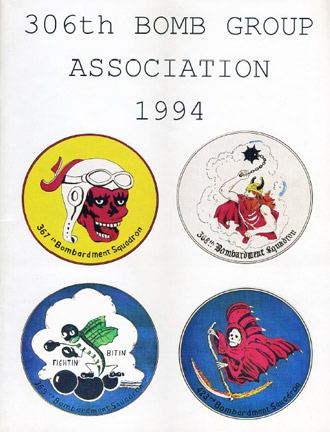
File Size 3.3 Mb |
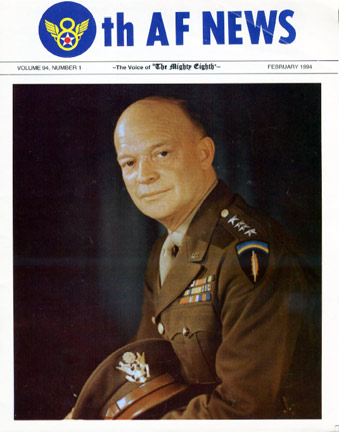
File Size 9.1 Mb |
|
306th Bomb Group Historical Association
Directory, 1994 - the first directory produced on a computer.
Select pages including detailed map of Bedford
area, England on inside front cover, table of contents with photo of
"Rose of York" being christened by Princess Elizabeth, King George
VI, Queen Elizabeth, and Lt. Gen. James Doolittle, page on which Lt.
Cushing is listed, and association by-laws.
As well-known as
the 306th was becoming were the four squadrons and their picturesque
names: the 367th or Clay Pigeons; the 368th or Eager Beavers; the
369th, or Fightin' Bitin'; and the 423rd or Grim reapers.
Clay Pigeons
Originally known as The Red Ape Skulls, they were dubbed the Clay
Pigeons by a Saturday Evening Post correspondent, because as one of
the members said, "They went down just like clay pigeons, losses
were so heavy." The name the 367th had acquired stuck, and by the
end of the year 1942 the squadron, in truth, appeared to be living
up to it. It seemed for a time that no one could possibly stay in
combat in that squadron and survive. Losses were heavier than those
of any other squadron in the European Theater of Operations at that
time, but the caliber of the work of the men behind the planes was
evident in the comparatively few turn backs due to mechanical
failure.
|
8th AF News, Vol. 94, #1 - Feb. 1994
Selected pages including publishing info page,
table of contents, President's Corner, Article about Eisenhower
Library Commemorates D-Day, list of aircraft names for which more
info is being sought, The Mighty 8th on the Roads of Britain, The
True Story of the Winged Boot, The Fog of War, Comrades Honor Man
Who Defied Gravity.
The Eighth Bomber Command (Re-designated 8th
AF in February 1944) was activated as part of the United States Army
Air Forces January 28, 1942, at Hunter Field in Savannah, Georgia.
Brigadier General Ira C. Eaker took the headquarters to England the
next month to prepare for its mission of conducting aerial
bombardment missions against Nazi-occupied Europe. During World War
II, under the leadership of such Generals as Eaker and Jimmy
Doolittle, the 8th AF became the greatest air armada in history. By
mid-1944, the 8th AF had reached a total strength of more than
200,000 people (it is estimated that more than 350,000 Americans
served in 8th AF during the war in Europe). At its peak, the 8th AF
could dispatch more than 2,000 four-engine bombers and 1,000
fighters on a single mission. For these reasons, the 8th AF became
known as the “Mighty Eighth”
(From "History
of the Mighty Eighth Air Force" at the National Museum of the
Mighty Eighth Air Force.) |
Fightin' Bitin'
During the early part of 1943, the 369th, known as Fightin' Bitin',
established the phenomenal record of completing 42 consecutive
missions without loss. This almost unbelievable feat started
on the first Wilhelmshaven attack and was broken on the July 29th
mission to Kiel. The record stood until after D-Day, when of
course, several squadrons in many groups broke it. However,
the fact remains that the Fightin' Bitin' accomplished this
remarkable action when the opposition by the Luftwaffe was at its
fiercest.Eager Beavers
The 368th, or "Eager Beaver" Squadron, fully lived up to its name by
being the first heavy bombardment squadron in the ETO to drop 1,000
tons on the Nazi war effort. The squadron's semi-official
mascot was an old white horse that lived in a field adjacent to the
squadron area. Many a time the nag was startled into sudden
activity by flare guns fired by exuberant combat men following a
particularly successful mission or squadron party. Most famous
of the Eager Beaver barracks is the Flak Happy Home and the equally
famous inscription over the door, "Through these portals pass the
most flak happy men in the world."
Grim Reapers
The 423rd squadron had a bad time in acquiring a name for itself.
Known originally asas the Grim Reapers it was advised to change the
name as itit was too grim and the German propaganda department might
take advantage of It. The squadron resigned itself to the relatively
tame Fiery Phantoms until "some high brass somewhere approved the
original name." Now it's officially the Grim Reapers again. On the
423rd site is the famous barracks building known Dingleberry Hall.
Names that will live in the pages of books are scribbled on the
walls of Dingleberry.
(From "First Over Germany" A Story of the
306th Bombardment Group - by Arthur P. Bove, 1945.
See the
entire PDF here.) |
|
306th Bomb Group Crew Photos |
306th Bomb Group
Website |
|
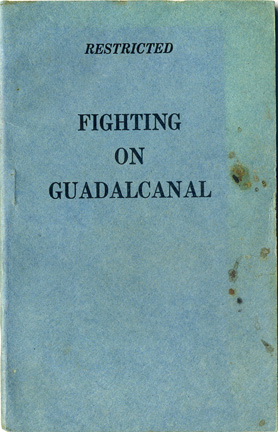
Fighting on Guadalcanal
A collection of advice given by numerous experienced military
personnel as told to Col. Russell P. Reeder. Guadalcanal is
the principal island in Guadalcanal Province of the nation of
Solomon Islands in the South-Western Pacific.
|
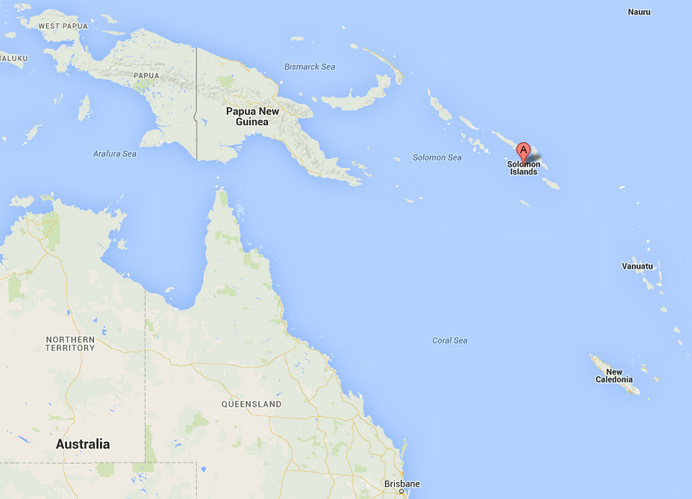
Red dot marks location of Guadalcanal |
|
Home
Photos
Books & Magazines
Documents
Objects
Related TampaPix Features:
Drew Field Echoes -
A History of the Army airbase and Tampa's first international airport
MacDill Air Force Base History and 1976 Air Show
Tampa in the 1940s
TampaPix Home |
|
